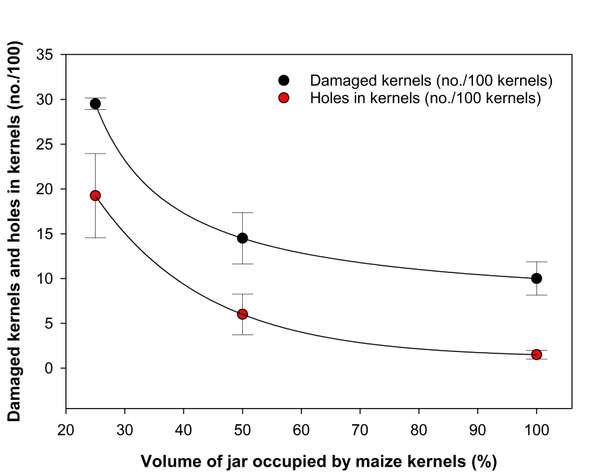Introduction
Postharvest losses inflicted by insect pests in stored grains represent major challenge smallholder famers face in the global South. The maize weevil (Sitophilus zeamais) is one of the most important postharvest pests in maize. With dry maize stored in woven polypropylene bags, Likhayo et al. (2018) found that insect pests (maize weevils and another maize pest called the lesser grain borer [Prostephanus truncatus]) reduced grain weight by 36%. Such losses threaten farmers’ food security and overall financial stability.
Extensive research has investigated postharvest control of insect pests (including maize weevil). Practices that have been studied include the use of resistant varieties (Abebe et al., 2009), airtight storage bags (Likhayo et al., 2018), and maize cob powder (Nwosu and Nwosu, 2012). ECHO has also explored the use of sealed containers using the following techniques/strategies:
- Removal of oxygen with vacuum sealing
- Replacement of oxygen with carbon dioxide
All these techniques aim at reducing the amount of oxygen available to the pests within the empty spaces in a container, thus increasing their chances of suffocation. However, some equipment used to remove or replace oxygen may be out of reach to farmers and converting maize cob to powder may be time consuming and/or costly. That is why we decided to investigate the control of S. zeamais by simply increasing the volume (of a sealed storage container) occupied by the seeds, which reduces the volume of air (with the oxygen it contains) available to the weevils. We hypothesized that reducing air space within sealed containers will help control maize weevil in stored maize seeds by depriving them of oxygen. This approach works if the container is hermetically sealed, meaning that there are no leaks that would allow the movement of outside air into the container.
Methods
.jpg?w=200)
Figure 1. Overview of the weevil control experiment laid out as a RCBD with 4 reps and 3 treatments (F=Full; H=Half and Q=Quarter).
To conduct the experiment, we used 12 jars that we filled with maize seeds (Figure 1) as follows:
- 4 jars with 100% of their volume occupied with seeds = Full.
- 4 jars with 50% of their volume occupied with seeds = Half
- 4 jars with 25% of their volume occupied with seeds = Quarter
Twenty live maize weevils were added to each container before hermetically sealing (by screwing the lid on tight) and placed in a screened in porch for six months at ambient conditions. At the end of the six-month trial period, response variables for which data were collected included the following:
- Number of live weevils (no./jar)
- Number of dead weevils (no./jar)
- Powder mass (g/jar)
- Damaged kernels (no./100 kernels)
- Holes in kernels (no./100 kernels)
Damaged kernels were those that were not whole, had holes, or had large discolorations from the weevil's mandibles.
Results
Results for the parameters investigated, though not all statistically significant, met our expectations of less weevil damage with full than partially filled (25% to 50%) containers (Table 1 and Figure 2). None of the treatments achieved 100% mortality, but the damage caused by weevils was lower in jars 100% full than partially filled jars.
| Weevils present | Weevil damage indicators | ||||
|---|---|---|---|---|---|
| Seed volume (% of jar) | Live weevils (no./jar) | Dead weevils (no./jar) | Powder mass (g/jar) | Damaged kernels (no./100 kernels) | Holes in kernels (no./100 kernels) |
| 25 | 54 | 53 | 0.78 | 30 | 19 |
| 50 | 14 | 40 | 0.39 | 14 | 6 |
| 100 | 4 | 29 | 0.21 | 10 | 2 |
| Significance (P)* | 0.1184 | 0.0950 | 0.0830 | 0.0030* | 0.0200* |
|
*The effect of seed volume on a measured variable is indicated by a P value of ≤ 0.05. See Figure 2 for trend lines representing significant effects of seed volume on damaged kernels and holes in kernels. |
|||||

Figure 2. Number of damaged kernels (black) and holes in kernels (red) for the three volumes of seed in jars with a regression line included.
Conclusion
In conclusion, these results fell in line with our hypothesis that the emptier the space within the sealed containers, the more oxygen available for the weevils, thus, the longer they will survive/proliferate and negatively impact maize kernels over time. Our findings suggest that filling up containers completely full of seeds, and keeping them hermetically sealed, can help control maize weevils in stored maize seeds. Limiting weevils’ access to oxygen in this way may not completely control them, but it can reduce their feeding activity. This quite simple method, therefore, is something that farmers can easily do to help reduce postharvest loss. This method can be coupled with other strategies, like those mentioned earlier, to increase the level of weevil control in maize seed. Findings have implications for storing seeds for consumption or future planting.
Cite as:
Dareus, R. 2021. Fill it Full: A Simple Way to Reduce Weevil Damage in Maize Seed Stored in Airtight Containers. ECHO Research Notes 2(5).
Literature Cited
Abebe, F., Tefera, T., Mugo, S., Beyene, Y., and Vidal, S. 2009. Resistance of maize varieties to the maize weevil Sitophilus zeamais (Motsch.) (Coleoptera: Curculionidae). African Journal of Biotechnology, 8:21.
Likhayo, P., A. Y. Bruce, T. Tefera, and J. Mueke. 2018. Maize Grain Stored in Hermetic Bags: Effect of Moisture and Pest Infestation on Grain Quality. Journal of Food Quality. 3:1-9. DOI:10.1155/2018/2515698
Nwosu, L. C., and Nwosu, U. I. (2012). Assessment of maize cob powder for the control of weevils in stored maize grain in Nigeria. Journal of Entomological Research, 36(3), 195-199.